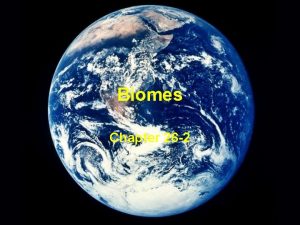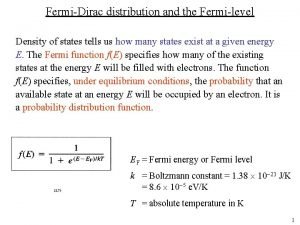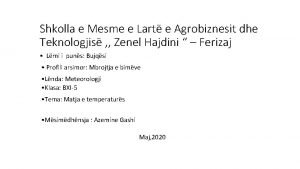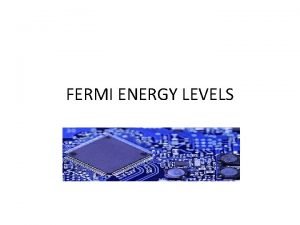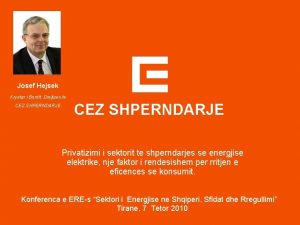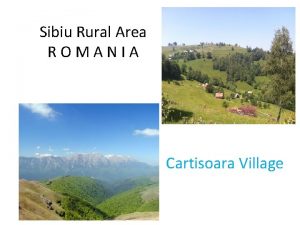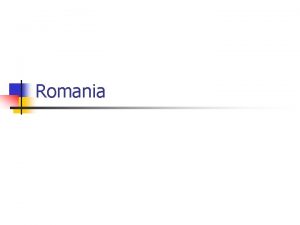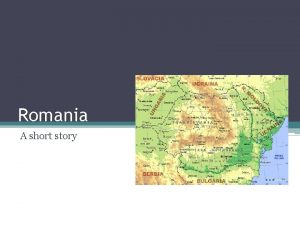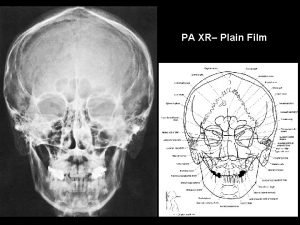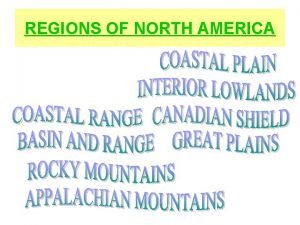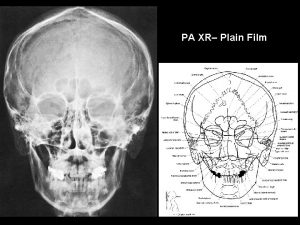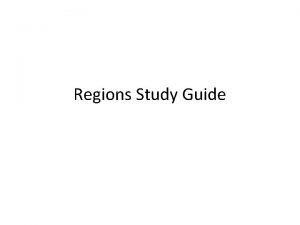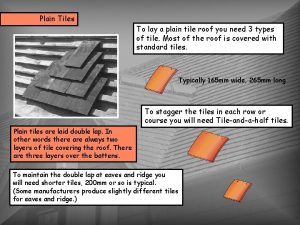Soil Temperatures of the Transylvanian Plain Romania D






























































- Slides: 62

Soil Temperatures of the Transylvanian Plain, Romania D. Weindorf 1, B. Haggard 1, T. Rusu 2, H. Cacovean 2, S. Johnson 1 1 LSU Ag. Center, Baton Rouge, LA, USA 2 USAMV, Cluj-Napoca, Romania

Objectives 1. Characterize the soil resources and establish a network of datalogging stations to measure soil temperatures across the Transylvanian Plain (TP) 2. Develop interpolated soil temperature regimes from collected data

Objectives 3. Evaluate variables such as slope inclination and aspect which impact soil temperatures 4. Make recommendations to farmers on optimal planting dates based on growing degree data from temperature study

Location

Location • Transylvanian Plain – Area: 395, 616 ha – Elev. : 231 -662 m – Landform: Rolling hills

Transylvanian Plain (TP)

Soils of the TP • • • Digital soils map created – Original 1: 200, 000 scale maps were georeferenced and digitized – 1, 472 soil polygons digitized – Classification updated to reflect SRTS 2003 Strongly influenced by – Topographic relief – Stream dissection – Land use / management Prone to gully and slump erosion on south facing slopes and those underlain by calcareous marls

Soil Order Antrisoluri Cambisoluri Cernisoluri Hidrisoluri Luvisoluri Pelisoluri Protisoluri Salsodisoluri Total: Area (ha) % of TP 58921 14. 9% 35679 9. 0% 200543 50. 7% 6816 1. 7% 86410 21. 8% 6737 1. 7% 154 0. 0% 356 0. 1% 395616 100. 0%

Soil Type Aluviosol Antrosol Cernoziom Eutricambosol Faeoziom Gleiosol Luvosol Preluvosol Solonceac Solonet Vertosol Total: Area (ha) % of TP 154 0. 0% 58921 14. 9% 81194 20. 5% 35679 9. 0% 119349 30. 2% 6816 1. 7% 52990 13. 4% 33420 8. 4% 120 0. 0% 236 0. 1% 6737 1. 7% 395616 100. 0%

Soil Subdivision Area (ha) % of TP Aluviosol calcaric 154 0. 0% Antrosol 58921 14. 9% Cernoziom argic 12539 3. 2% Cernoziom cambic 68655 17. 4% Eutricambosol tipic 35679 9. 0% Faeoziom clinogleic 29922 7. 6% Faeoziom gleic 14310 3. 6% Faeoziom tipic 75117 19. 0% Gleiosol calcaric 6816 1. 7% Luvosol albic 57 0. 0% Luvosol tipic 52933 13. 4% Preluvosol tipic 33420 8. 4% Solonceac tipic 120 0. 0% Solonet tipic 236 0. 1% Vertosol tipic 6737 1. 7% Total: 395616 100. 0%

Background • 20 sites across TP – 10 with rainfall data – 10 online in March 2008 – 10 online in March 2009

Configuration (+ Rainfall) • HOBO Microstation – Soil moisture at 10 cm – Soil temperature at 10, 30, 50 cm • Tipping bucket rain gauge – Air temperature – Rainfall

Configuration (- Rainfall) • HOBO Microstation – Soil moisture at 10 cm – Soil temperature at 10, 50 cm – Air temperature at 0 cm

Hoboware Pro

Transects • North-South – Nuseni-Balda-Band • West-East – Cojocna-Sillivasu. Voinceni • Selection of transects based on length of available data and consistent configuration of probes

Transect Differences • Duncan’s post hoc test was run on all of the sites for March, April, May, June, and July 2009 • For Cojocna-Sillivasu-Voinceni (W -E) – Voinceni is significantly different • For Nuseni-Balda-Band (N-S) – Nuseni is significantly different

Cojocna • Typic Haplustoll • Cernoziom Cambic • Slope: 10 -14% • Aspect: NNE • Backslope • 579 m

Sillivasu • Humic Dystrudept • Disticambosol molic • Slope: 5 -9% • Aspect: NW • Footslope • 463 m

Voinceni • Aquertic Hapludoll • Faeoziom gleic • Slope: 0 -1% • Aspect: SE • Toeslope • 345 m

Cojocna-Sillivasu-Voinceni (W-E)

Cojocna-Sillivasu-Voinceni (W-E)

00: 00 Voinceni

00: 00

02: 00

04: 00

06: 00

08: 00

10: 00

12: 00

14: 00

16: 00

18: 00

20: 00

22: 00

Nuseni • Aquic Hapludert • Vertisol pseudogleizat – Further observation needed to confirm classification • • Slope: 30% Aspect: SE Backslope 296 m

Balda • Vertic Haplustoll • Cernoziom vertic • Slope: 10 -14% • Aspect: ENE • Backslope • 360 m

Band • Typic Haplustoll • Cerniziom cambic • Slope: 0 -1% • Aspect: SE • Toeslope • 318 m

Nuseni-Balda-Band (N-S)

Nuseni-Balda-Band (N-S)

00: 00 Nuseni Balda Nuseni Band

00: 00 Balda Nuseni Band

02: 00 Balda Nuseni Band

04: 00 Balda Nuseni Band

06: 00 Balda Nuseni Band

08: 00 Balda Nuseni Band

10: 00 Balda Nuseni Band

12: 00 Balda Nuseni Band

14: 00 Balda Nuseni Band

16: 00 Balda Nuseni Band

18: 00 Balda Nuseni Band

20: 00 Balda Nuseni Band

22: 00 Balda Nuseni Band

Growing Degree Days (GDD) • GDD are a method used to measure the energy that is needed by a crop to grow – Uses air temperature – Calculated by selecting a base value, which varies by crop • GDD are accumulated starting the day after planting – If the corn was planted on 4/21/09 – Accumulation starts on 4/22/09

GDD Crop Base Temperature (C) Corn 10 Sugar Beet 1. 1 Wheat 0 Sunflower 6. 7 Barley 0 Beans 10

GDD • Evaluated from 3/6/09 – 7/19/09 • Accumulated GDD ranged from – 743 -1171 for Baskerville-Emin (Baskerville and Emin, 1969) – 689 -1059 for Averaging (Arnold, 1960)

M c at Zo ei Vo ren in i ce Tr ni ite n D i U ipsa ng ur N as us Si en lliv i a C su ai an u Ju C cu oj oc na Ta g Ba a ld a B Br an an d is te a Za C Fi ra u lp ie is s u ti M ar Lu e du s Si GDD 1400 1200 1000 800 BE_F 600 Avg_F 400 BE_mm Avg_mm 200 0

DOY that AGDD reached 694 • Spline interpolation using averaging method • 694 AGDD is an approximation of GDD needed for 100 day corn to tassel

DOY that AGDD reached 694 • Using Baskerville -Emin • Craiesti and Filpisu Mare were the first to reach 694 AGDD

Conclusions • Differences exist across the plain, as is shown in the interpolation maps • The southeastern portion is the warmest area of the plain, with other warm spots around Taga and Branistea • There is a 425 AGDD difference between Sic and Filpisu Mare based on BE-F

Future Work • This fall and winter will be the first cool season data for the 10 new stations – Full year and monthly interpolation maps of temperature data will be created as the new data is collected • Next year corn will be monitored to compare the developmental stages to the GDD in the Transylvanian Plain

Acknowledgements • • • Dr. Yuanda Zhu Mrs. Stephanie Whitaker Mrs. Noura Bakr Mr. Somsubhra Chakraborty LSU Ag. Center USAMV-Cluj

Questions?
 Four major spheres of the earth
Four major spheres of the earth Living soil vs dead soil
Living soil vs dead soil Canada heat wave temperatures
Canada heat wave temperatures Outline classification of phylum chordata
Outline classification of phylum chordata Fermi function
Fermi function Rutgers sea water temps mid atlantic
Rutgers sea water temps mid atlantic What is cleaning servsafe
What is cleaning servsafe A biome that is cold, dry and treeless.
A biome that is cold, dry and treeless. Tempering chocolate temperatures chart celsius
Tempering chocolate temperatures chart celsius Fermi dirac distribution function tells.
Fermi dirac distribution function tells. Law of intermediate temperatures
Law of intermediate temperatures Instrumenti per matjen e temperatures se ajrit
Instrumenti per matjen e temperatures se ajrit Fermi-dirac distribution function at different temperatures
Fermi-dirac distribution function at different temperatures Phản ứng thế ankan
Phản ứng thế ankan Quá trình desamine hóa có thể tạo ra
Quá trình desamine hóa có thể tạo ra Các môn thể thao bắt đầu bằng tiếng chạy
Các môn thể thao bắt đầu bằng tiếng chạy Sự nuôi và dạy con của hổ
Sự nuôi và dạy con của hổ điện thế nghỉ
điện thế nghỉ Biện pháp chống mỏi cơ
Biện pháp chống mỏi cơ Trời xanh đây là của chúng ta thể thơ
Trời xanh đây là của chúng ta thể thơ Voi kéo gỗ như thế nào
Voi kéo gỗ như thế nào Thiếu nhi thế giới liên hoan
Thiếu nhi thế giới liên hoan Phối cảnh
Phối cảnh Một số thể thơ truyền thống
Một số thể thơ truyền thống Các châu lục và đại dương trên thế giới
Các châu lục và đại dương trên thế giới Thế nào là hệ số cao nhất
Thế nào là hệ số cao nhất Sơ đồ cơ thể người
Sơ đồ cơ thể người Thế nào là số nguyên tố
Thế nào là số nguyên tố Tư thế ngồi viết
Tư thế ngồi viết Hình ảnh bộ gõ cơ thể búng tay
Hình ảnh bộ gõ cơ thể búng tay đặc điểm cơ thể của người tối cổ
đặc điểm cơ thể của người tối cổ Mật thư tọa độ 5x5
Mật thư tọa độ 5x5 Tư thế worms-breton
Tư thế worms-breton ưu thế lai là gì
ưu thế lai là gì Thẻ vin
Thẻ vin Bàn tay mà dây bẩn
Bàn tay mà dây bẩn Thơ thất ngôn tứ tuyệt đường luật
Thơ thất ngôn tứ tuyệt đường luật Các châu lục và đại dương trên thế giới
Các châu lục và đại dương trên thế giới Từ ngữ thể hiện lòng nhân hậu
Từ ngữ thể hiện lòng nhân hậu Bổ thể
Bổ thể Tư thế ngồi viết
Tư thế ngồi viết Diễn thế sinh thái là
Diễn thế sinh thái là Frameset trong html5
Frameset trong html5 Thế nào là giọng cùng tên?
Thế nào là giọng cùng tên? Làm thế nào để 102-1=99
Làm thế nào để 102-1=99 Chúa yêu trần thế alleluia
Chúa yêu trần thế alleluia Hươu thường đẻ mỗi lứa mấy con
Hươu thường đẻ mỗi lứa mấy con đại từ thay thế
đại từ thay thế Vẽ hình chiếu vuông góc của vật thể sau
Vẽ hình chiếu vuông góc của vật thể sau Cong thức tính động năng
Cong thức tính động năng Tỉ lệ cơ thể trẻ em
Tỉ lệ cơ thể trẻ em Thế nào là mạng điện lắp đặt kiểu nổi
Thế nào là mạng điện lắp đặt kiểu nổi Lời thề hippocrates
Lời thề hippocrates Dot
Dot Vẽ hình chiếu đứng bằng cạnh của vật thể
Vẽ hình chiếu đứng bằng cạnh của vật thể Pompă cu pistoane axiale românia
Pompă cu pistoane axiale românia Prodhimi i brendshem bruto
Prodhimi i brendshem bruto Romania in anul 1938
Romania in anul 1938 Proiect educativ 1 decembrie
Proiect educativ 1 decembrie Pasari rapitoare romania
Pasari rapitoare romania Sibiu area
Sibiu area Romania vecini si limite
Romania vecini si limite Christmas in romanian
Christmas in romanian







